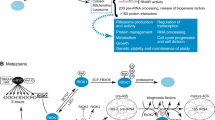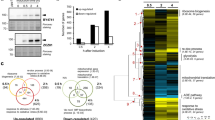Abstract
Eukaryotic initiation factor 5A (eIF5A) is the only protein in nature that contains hypusine, an unusual amino acid derived from the modification of lysine by spermidine. Two genes, TIF51A and TIF51B, encode eIF5A in the yeast Saccharomyces cerevisiae. In an effort to understand the structure–function relationship of eIF5A, we have generated yeast mutants by introducing plasmid-borne tif51A into a double null strain where both TIF51A and TIF51B have been disrupted. One of the mutants, tsL102A strain (tif51A L102A tif51aΔ tif51bΔ) exhibits a strong temperature-sensitive growth phenotype. At the restrictive temperature, tsL102A strain also exhibits a cell shape change, a lack of volume change in response to temperature increase and becomes more sensitive to ethanol, a hallmark of defects in the PKC/WSC cell wall integrity pathway. In addition, a striking change in actin dynamics and a complete cell cycle arrest at G1 phase occur in tsL102A cells at restrictive temperature. The temperature-sensitivity of tsL102A strain is due to a rapid loss of mutant eIF5A with the half-life reduced from 6 h at permissive temperature to 20 min at restrictive temperature. Phenylmethyl sulfonylfluoride (PMSF), an irreversible inhibitor of serine protease, inhibited the degradation of mutant eIF5A and suppressed the temperature-sensitive growth arrest. Sorbitol, an osmotic stabilizer that complement defects in PKC/WSC pathways, stabilizes the mutant eIF5A and suppresses all the observed temperature-sensitive phenotypes.










Similar content being viewed by others
References
Bassell G, Singer RH (1997) mRNA and cytoskeletal filaments. Curr Opin Cell Biol 9:109–115
Boeke JD, Trueheart J, Natsoulis G, Fink GR (1987) 5-Fluoroorotic acid as a selective agent in yeast molecular genetics. Methods Enzymol 154:164–175
Carr-Schmid A, Valente L, Loik VI, Williams T, Starita LM, Kinzy TG (1999) Mutations in elongation factor 1, a guanine nucleotide exchange factor, enhance translational fidelity. Mol Cell Biol 19:5257–5266
Chen KY, Jao DL (1999) Chemistry of hypusine formation on eukaryotic initiation factor 5A in biological systems. J Chinese Chem Soc 46:727–734
Chen KY, Liu AY (1997) Biochemistry and function of hypusine formation on eukaryotic initiation factor 5A. Biol Signals 6:105–109
Chen ZP, Chen KY (1997) Marked elevation of hypusine formation activity on eukaryotic initiation factor 5A in v-HA-RAS transformed mouse NIH3T3 cells. Cancer Lett 115:235–241
Chen ZP, Yan YP, Ding QJ, Knapp S, Potenza JA, Chen KY (1996) Effects of inhibitors of deoxyhypusine synthase on the differentiation of mouse neuroblastoma and erythroleukemia cells. Cancer Lett 105:233–239
Eberhardt I, Hohmann S (1995) Strategy for deletion of complete open reading frames in Saccharomyces cerevisiae. Curr Genet 27:306–308
Giaever G, Chu AM, Ni L, Connelly C, Riles L, Veronneau S, Dow S, Lucau-Danila A, et al. (2002) Functional profiling of the Saccharomyces cerevisiae genome. Nature 418:387–391
Gietz D, St Jean A, Woods RA, Schiestl RH (1992) Improved method for high efficiency transformation of intact yeast cells. Nucleic Acids Res 20:1425
Hanauske-Abel HM, Slowinska B, Zagulska S, Wilson RC, Staiano-Coico L, Hanauske AR, McCaffrey T, Szabo P (1995) Detection of a sub-set of polysomal mRNAs associated with modulation of hypusine formation at the G1-S boundary. Proposal of a role for eIF-5A in onset of DNA replication. FEBS Lett 366:92–98
Heinisch JJ, Lorberg A, Schmitz HP, Jacoby JJ (1999) The protein kinase C-mediated MAP kinase pathway involved in the maintenance of cellular integrity in Saccharomyces cerevisiae. Mol Microbiol 32:671–680
Hesketh J (1994) Translation and the cytoskeleton: a mechanism for targeted protein synthesis. Mol Biol Rep 19:233–243
Jakus J, Wolff EC, Park MH, Folk JE (1993) Features of the spermidine-binding site of deoxyhypusine synthase as derived from inhibition studies. Effective inhibition by bis- and mono-guanylated diamines and polyamines. J Biol Chem 268:13151–13159
Jao DL, Chen KY (2005) Tandem affinity purification revealed the hypusine-dependent binding of eukaryotic initiation factor 5A to the translating 80S ribosomal complex. J Cell Biochem (in press)
Kang HA, Hershey JW (1994) Effect of initiation factor eIF-5A depletion on protein synthesis and proliferation of Saccharomyces cerevisiae. J Biol Chem 269:3934–3940
Karpova TS, Moltz SL, Riles LE, Guldener U, Hegemann JH, Veronneau S, Bussey H, Cooper JA (1998) Depolarization of the actin cytoskeleton is a specific phenotype in Saccharomyces cerevisiae. J Cell Sci 111:2689–2696
Kim KK, Hung LW, Yokota H, Kim R, Kim SH (1998) Crystal structures of eukaryotic translation initiation factor 5A from Methanococcus jannaschii at 1.8 A resolution. Proc Natl Acad Sci USA 95:10419–10424
Levin DE, Bartlett-Heubusch E (1992) Mutants in the S. cerevisiae PKC1 gene display a cell cycle-specific osmotic stability defect. J Cell Biol 116:1221–1229
Li Y, Moir RD, Sethy-Corasi IK, Warner JR, Willis IM (2000) Repression of ribosome and tRNA synthesis in secretion-defective cells is signaled by a novel branch of the cell integrity pathway. Mol Cell Biol 20:3843–3851
Li AL, Li HY, Jin BF, Ye QN, Zhou T, Yu XD, Pan X, Man JH, He K, Yu M, Hu MR, Wang J, Yang SC, Shen BF, Zhang XM (2004) A novel eIF5A complex functions as a regulator of p53 and p53-dependent apoptosis. J Biol Chem 279:49251–49258
Madden K, Sheu YJ, Baetz K, Andrews B, Snyder M (1997) SBF cell cycle regulator as a target of the yeast PKC-MAP kinase pathway. Science 275:1781–1784
Lipowsky G, Bischoff FR, Schwarzmaier P, Kraft R, Kostka S, Hartmann E, Kutay U, Gorlich D (2000) Exportin 4: a mediator of a novel nuclear export pathway in higher eukaryotes. EMBO J 19:4362–4371
Liu YP, Nemeroff MY, Yan P, Chen KY (1997) Interaction of eukaryotic initiation factor 5A with the human immunodeficiency virus type 1 Rev response element RNA and U6 snRNA requires deoxyhypusine or hypusine modification. Biol Signals 6:166–174
Murzin AG (1993) OB(oligonucleotide/oligosaccharide binding)-fold: common structural and functional solution for non-homologous sequences. EMBO J 12:861–867
Narumiya S (2003) Signal transduction underlying cell morphogenesis: editorial overview. J Biochem (Tokyo) 134:305–307
Neufeld TP, Edgar BA (1998) Connections between growth and the cell cycle. Curr Opin Cell Biol 10:784–790
Paravicini G, Cooper M, Friedli L, Smith DJ, Carpentier JL, Klig LS, Payton MA (1992) The osmotic integrity of the yeast cell requires a functional PKC1 gene product. Mol Cell Biol 12:4896–4905
Park MH, Wolff EC, Lee YB, Folk JE (1994) Antiproliferative effects of inhibitors of deoxyhypusine synthase. J Biol Chem 269:27827–27832
Park MH, Lee YB, Joe YA (1997) Hypusine is essential for eukaryotic cell proliferation. Biol Signals 6:115–123
Peat TS, Newman J, Waldo GS, Berendzen J, Terwilliger TC (1998) Structure of translation initiation factor 5A from Pyrobaculum aerophilum at 1.75 A resolution. Structure 6:1207–1214
Pruyne D, Bretscher A (2000) Polarization of cell growth in yeast. J Cell Sci 113:571–585
Pollard TD (2002) Formins initiate new actin filaments. Nat Cell Biol 4:E191
Madden K, Snyder M (1998) Cell polarity and morphogenesis in budding yeast. Annu Rev Microbiol 52:687–744
Pochon F, Cohen SS (1972) 4-Thiouridine and the conformation of E. coli tRNA induced by spermidine.Biochem. Biophys Res Commun 47:720–726
Rosorius O, Reichart B, Kratzer F, Heger P, Dabauvalle MC, Hauber J (1999) Nuclear pore localization and nucleocytoplasmic transport of eIF-5A: evidence for direct interaction with the export receptor CRM1. J Cell Sci 112:2369–2380
Sasaki K, Abid MR, Miyazaki M (1996) Deoxyhypusine synthase gene is essential for cell viability in the yeast Saccharomyces cerevisiae. FEBS Lett 384:151–154
Schnier J, Schwelberger HG, Smit-Mcbride Z, Kang HA, Hershey JW (1991) Translation initiation factor 5A and its hypusine modification are essential for cell viability in the yeast Saccharomyces cerevisiae. Mol Cell Biol 11:3105–3114
Sherman F, Fink GR, Hicks JB (1986) Methods in yeast genetics: a laboratory course manual. Cold Spring Harbor Laboratory Press, Cold Spring Harbor
Shi XP, Yin KC, Zimolo ZA, Stern AM, Waxman L (1996) The subcellular distribution of eukaryotic translation initiation factor, eIF-5A, in cultured cells. Exp Cell Res 225:348–356
Stage-Zimmermann T, Schmidt U, Silver PA (2000) Factors affecting nuclear export of the 60S ribosomal subunit in vivo. Mol Biol Cell 11:3777–3789
Stapulionis R, Kolli S, Deutscher MP (1997) Efficient mammalian protein synthesis requires an intact F-actin system. J Biol Chem 272:24980–24986
Valentini SR, Casolari JM, Oliveira CC, Silver PA, McBride AE (2002) Genetic interactions of yeast eukaryotic translation initiation factor 5A (eIF5A) reveal connections to poly(A)-binding protein and protein kinase C signaling. Genetics 160:393–405
Verna J, Ballester R (1999) A novel role for the mating type (MAT) locus in the maintenance of cell wall integrity in Saccharomyces cerevisiae. Mol Gen Genet 261:681–689
Verna J, Lodder A, Lee K, Vagts A, Ballester R (1997) A family of genes required for maintenance of cell wall integrity and for the stress response in Saccharomyces cerevisiae. Proc Natl Acad Sci USA 94:13804–13809
Wohl T, Klier H, Ammer H, Lottspeich F, Magdolen V (1993) The HYP2 gene of Saccharomyces cerevisiae is essential for aerobic growth: characterization of different isoforms of the hypusine-containing protein Hyp2p and analysis of gene disruption mutants. Mol Gen Genet 241:305–311
Xu A, Chen KY (2001) Hypusine is required for a sequence-specific interaction of eukaryotic initiation factor 5A with postsystematic evolution of ligands by exponential enrichment RNA. J Biol Chem 276:2555–2561
Xu A, Jao DL, Chen KY (2004) Identification of messenger RNA that bind to eukaryotic initiation factor 5A by affinity co-purification and differential display. Biochem J 384:585–590
Yao M, Ohsawa A, Kikukawa S, Tanaka I, Kimura M (2003) Crystal structure of hyperthermophilic archaeal initiation factor 5A: a homologue of eukaryotic initiation factor 5A (eIF-5A). J Biochem 133:75–81
Zu T, Verna J, Ballester R (2001) Mutations in WSC genes for putative stress receptors result in sensitivity to multiple stress conditions and impairment of Rlm1-dependent gene expression in Saccharomyces cerevisiae. Mol Genet Genomics 266:142–155
Zuk D, Jacobson A (1998) A single amino acid substitution in yeast eIF-5A results in mRNA stabilization. EMBO J 17:2914–2925
Acknowledgments
We are grateful to Dr. A Jacobson for providing us ts1159 and SS330 yeast strains and Dr. J.W.B. Hershey for sending us yeast eIF5A antibody. The work was supported by NIH grants RO1 CA49695 to KYC and GM62789 to TGK.
Author information
Authors and Affiliations
Corresponding author
Additional information
Communicated by S. Hohmann
Rights and permissions
About this article
Cite this article
Chatterjee, I., Gross, S.R., Kinzy, T.G. et al. Rapid depletion of mutant eukaryotic initiation factor 5A at restrictive temperature reveals connections to actin cytoskeleton and cell cycle progression. Mol Genet Genomics 275, 264–276 (2006). https://doi.org/10.1007/s00438-005-0086-4
Received:
Accepted:
Published:
Issue Date:
DOI: https://doi.org/10.1007/s00438-005-0086-4




